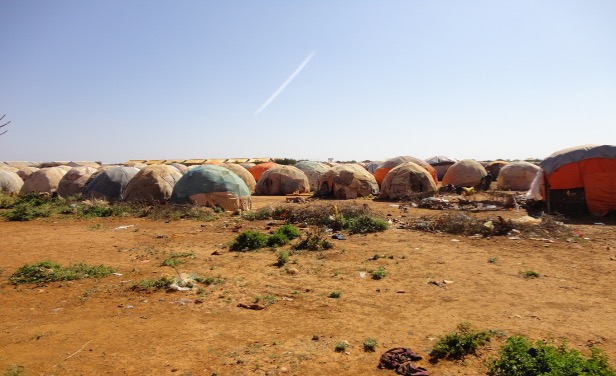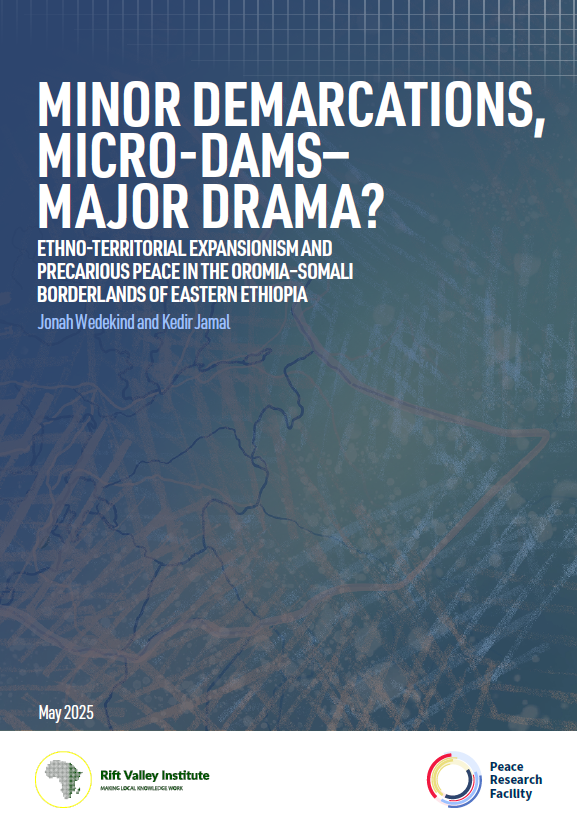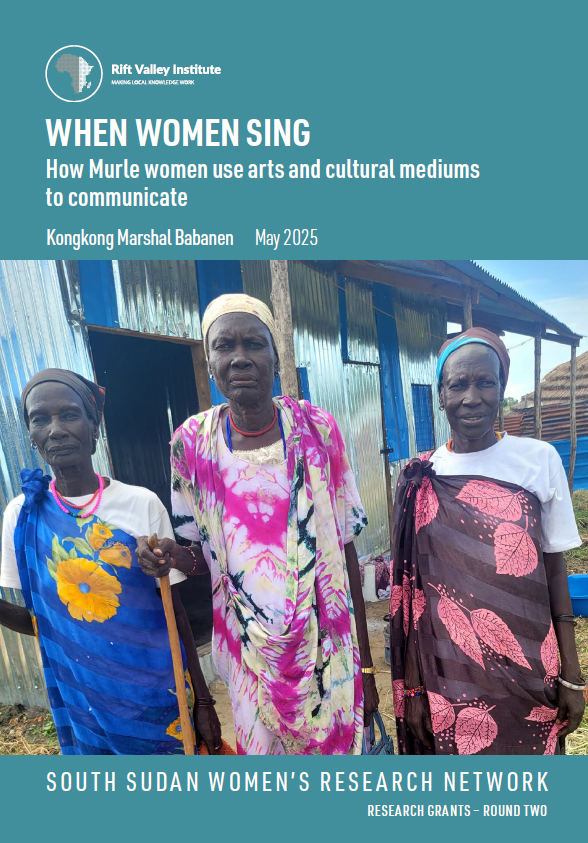The site of recurrent famines and humanitarian crises, Somalia’s Bay and Bakool regions were once considered the country’s breadbasket. In this blog, researcher and former development worker Abdirahman Edle explains how, over the past two decades, the region has changed from being a land of plenty to one of scarcity. The blog is the second in a series published by the Rift Valley Institute on understanding the causes of the drought-related crisis in the Somali regions of the Horn of Africa. It is a product of the XCEPT (Cross-Border Conflict Evidence, Policy and Trends) programme.

Bay and Bakool regions in Somalia’s South West State are often referred to as the country’s breadbasket.At present, over 80 per cent of the sorghum consumed by Somalis is produced in the rain-fed farms across Bay region, while livestock reared in Bay and Bakol, especially goats and camels, are highly valued in markets across the country.
However, the region also has a long history of droughts, which have often turned into famines, causing widespread suffering. Most prominent among these crises was the 1991/92 famine, which was caused by a combination of drought and civil war in the early years of state collapse. The capital of Bay region, Baidoa, gained the nickname ‘the city of death’ by international media in the early 1990s due to the numbers of people who died there during the famine. Droughts have continued to hit the region since 1992, the famine in 2011 being a particularly devastating example.
A decade later, according to FSNAU (Food Security and Nutrition Analysis Unit), Somalia is again experiencing a large-scale drought with more than 4.1 million people facing a state of acute food insecurity crisis, as defined by the Integrated Food Security Phase Classification (IPC phase 3). In June 2022, the number is predicted to hit 7.9 million, which is almost half the Somali population. Once more, Bay and Bakool regions are among the worst hit regions, with 188,220 people in Bay and 74,390 in Bakool classified as being in crisis.
The major drivers of droughts, and the associated food insecurity, are climate change combined with insecurity in the region, which has disrupted the lives and livelihoods of its people. A harsh tax regime imposed by the militant Islamist group Al-Shabaab, which controls most of the rural areas, has also contributed to upheaval amongst the population, making communities less able to cope with the drought conditions.
These combined factors have caused a mass movement of people out of the rural areas, which are mostly controlled by the Islamists, into the government-controlled cities. This has added to the already high number of internally displaced persons (IDPs) who mostly live in make-shift camps on the edges of urban areas.
From land of plenty to land of scarcity

Working as a development practitioner in Bay and Bakool for over fifteen years, I witnessed the rapid rate of agricultural change in the two regions. These changes have caused many people to lose their farming livelihoods, in particular sorghum cultivation. When I arrived in the region in 2004, locals would recall their past history of farming, emphasizing their self-sufficiency in sorghum with any surplus traded with other regions in Somalia and internationally.
The government of Siyad Barre (1969-1991) sought to tap the region’s agricultural potential and, in doing so, enhance food security. With this objective in mind, it established Agricultural Development Centres (ADCs), which were responsible for storing agricultural produce that the government bought at a fixed rate—usually during the harvest when the market was saturated and prices were low.
Ahmed, a veterinary specialist whom I met at the time and who had worked in the region in the 1980s, spoke positively about the ADCs. He saw them as being important for enhancing productivity through capacity building, infrastructural development (roads) and improvement of higher yield crop varieties.
The situation is different today. The region is struggling with recurrent droughts that are destroying livelihoods and transforming Somalia’s former breadbasket into an epicenter of hunger and starvation. A Baidoa resident I talked to recalled:
‘My city was known and still is known by the name ‘Baydhabo janaay’ (Baaydhabo Paradise) because of the ever-green environment and plenty of food. But gone are those old days as we continue to live in droughts year in, year out’.
The gradual erosion of agricultural livelihoods has been caused by several factors. These range from insecurity and high taxation to the effects of climate change. Another contributing factor is changes in agricultural production from food to cash crops—a consequence of increasing demand for simsim(sesame) and groundnuts by the Gulf countries, which provides agro-pastoralists with hard currency.
Political instability perpetuated by inter-clan fighting and warlordism has rocked the region, resulting in upheaval and population displacement since 1991. More recently, the expansion of the Al-Shabaab administration in Bay and Bakool has made life more difficult due to heavy taxation, authoritarian rule and a general climate of fear created by the Islamists, including the threat of recruiting children as soldiers.
Climate change has produced more regular and prolonged droughts, destructive floods and locust infestations. Lastly, rapid urbanization has influenced changes in eating preferences where imported food such as rice and spaghetti has overtaken the consumption of locally produced cereals, undermining conventional farming habits.
Bay and Bakool’s inhabitants are primarily agro-pastoralists and are therefore vulnerable to droughts. Mobility is one of the key coping mechanisms employed to deal with livelihood losses, and people from the two regions make up the majority of internally displaced people across Somalia. Many have been moving to cities and displaced people from rural Bay and Bakool can be found in Baidoa, Mogadishu, Lasanod and Bosaso.
However, IDPs often find that they are not welcomed by the residents of cities outside of their home regions. In recent months, the Puntland authorities deported incomers from outside the state who had sought refuge in Bosaso. The same thing happened in October 2021 in Lasanod, a city on Somaliland’s contested eastern frontier with Puntland.
Often, it is Digil-Mirifle who are expelled because they are suspected of being supporters of Al-Shabaab and accused of being responsible for violent attacks, such as those that took place recently in Lasanod. This is despite that fact that most Digil-Mirifle have fled their home region to escape Al-Shabaab and other clan-based conflict, insecurity and raiding in Bay and Bakool.
Baidoa’s unsustainable urbanisation
According to the Norwegian Refugee Council, the current drought has already displaced 245,000 people across Somalia with numbers projected to rise to 1.4 million as conditions worsen. Baidoa is already hosting a very large IDP population, which has resulted in the fast expansion of the city, increasing the commodification of urban land and triggering increases in the cost of housing.
A joint IDP site verification exercise conducted in April 2021 by a consortium of NGOs numbered the IDP population at 430,991. The number of in-migrants has soared since the onset of the current drought. Displaced people are found in 548 different camps—living in make-shift shelters—located at the peripheries of the city.
Like other Somali cities, Baidoa is not equipped or prepared to handle the spontaneous growth of its population. Rapid and unplanned urbanization threaten to make the city increasingly unsuitable for living. The local municipality is constrained by its financial resources, technical capacity and the social infrastructure required to provide basic urban services. Moreover, the in-migration of rural people is upending the city’s spatial clan arithmetic—settlement patterns in the city were historically organized on the basis of distinct sub-clan dominated neighborhoods. The stratified pattern of clan settlements determined resource distribution in the city, often allowing dominant clans to appropriate aid and development resources.

If unaddressed, Baidoa’s social-economic and political challenges—related to droughts and rural urban migration—will become a time-bomb waiting to explode. Funding is required to mitigate the devastating effects of drought in Bay and Bakool, particularly the effects of urban in-migration on the economy and the abandonment of traditional livelihood systems. Interventions addressing these structural challenges should draw on a careful contextual understanding of these crises.
People living in Bay and Bakool regions and in other parts of Somalia are in danger. In the event that humanitarian support is not delivered in time, the mistake of the failed response in 2011 will be repeated. While, in the short-term Bay and Bakool are unlikely to revert back to their status as Somalia’s breadbasket, it is imperative that both the immediate and long-term consequences of the current drought are addressed by Somali and external actors.
Abdirahman Edle is a doctoral student at University of Nairobi as part of the diaspora humanitarianism Project—a collaboration with the Danish Institute for International Studies (DIIS), Rako – Research and Communication Centre and RVI. He has worked as humanitarian, development worker and researcher in Somalia. He worked with RVI on several studies: Somalia Urbanization, Land study and Social Assessment.


